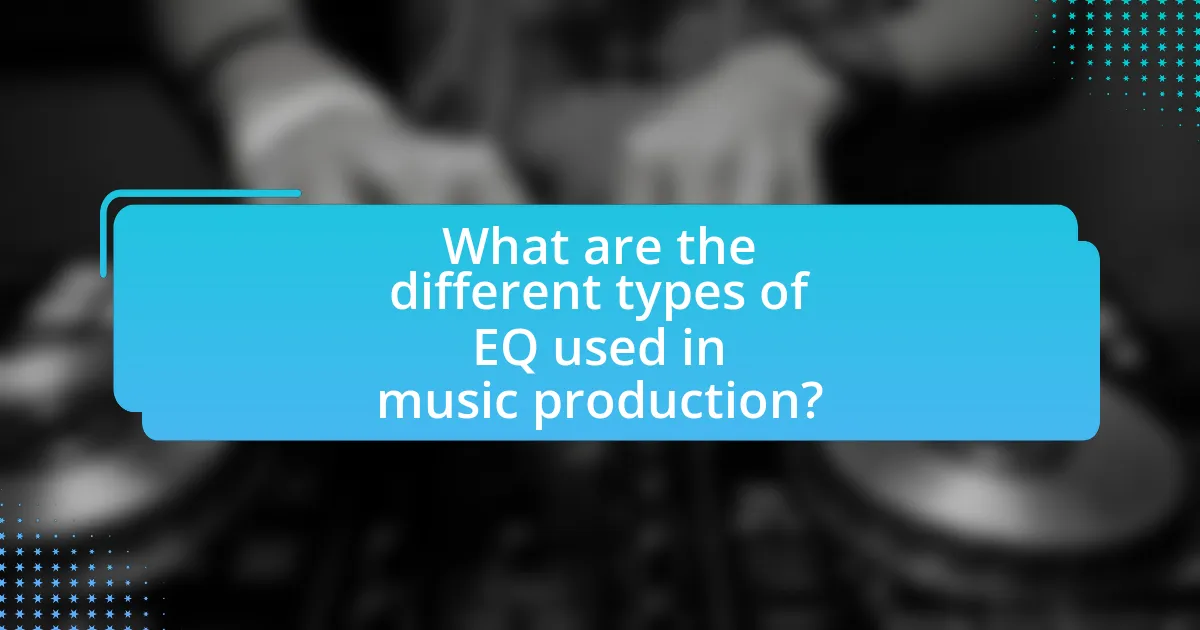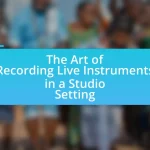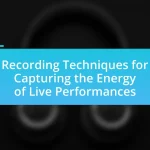The article focuses on the role of equalization (EQ) in shaping a band’s sound, emphasizing its importance in adjusting frequency balances for clearer mixes and distinct sonic identities. It explores how EQ influences the overall sound of a band, the fundamental principles of EQ in music production, and its effects on individual instruments. Additionally, the article discusses various types of EQ, best practices for studio and live settings, common challenges bands face, and practical tips for enhancing sound quality through effective EQ techniques. The content highlights the significance of proper EQ application in achieving a polished and professional sound that resonates with listeners.
What is the Role of EQ in Shaping Your Band’s Sound?
EQ, or equalization, plays a crucial role in shaping a band’s sound by adjusting the balance of frequencies in audio recordings or live performances. By manipulating specific frequency ranges, musicians and sound engineers can enhance or reduce certain elements of the sound, allowing for a clearer mix and a more defined sonic identity. For instance, boosting mid-range frequencies can make vocals more prominent, while cutting low frequencies can reduce muddiness in the mix. This precise control over frequency response is essential for achieving a polished and cohesive sound that resonates with listeners.
How does EQ influence the overall sound of a band?
EQ, or equalization, significantly influences the overall sound of a band by adjusting the balance of frequencies in the audio mix. This process allows sound engineers and musicians to enhance or reduce specific frequency ranges, which can clarify individual instruments, improve vocal presence, and create a cohesive sound. For example, boosting mid-range frequencies can make vocals stand out, while cutting low frequencies can reduce muddiness in the mix. Studies show that proper EQ settings can lead to a more polished and professional sound, as evidenced by the fact that many successful recordings utilize EQ adjustments to achieve clarity and balance among instruments.
What are the fundamental principles of EQ in music production?
The fundamental principles of EQ in music production include frequency balancing, resonance control, and dynamic range management. Frequency balancing involves adjusting the levels of different frequency ranges to ensure clarity and separation among instruments, which is essential for a well-defined mix. Resonance control focuses on reducing or enhancing specific frequencies to eliminate muddiness or harshness, thereby improving the overall tonal quality. Dynamic range management ensures that the mix maintains a consistent loudness level across various playback systems, allowing for a more polished sound. These principles are supported by the fact that effective EQ application can significantly enhance the listener’s experience by creating a more engaging and harmonious soundscape.
How does EQ affect individual instruments within a band?
EQ, or equalization, affects individual instruments within a band by adjusting their frequency response to enhance clarity and balance in the overall mix. For example, boosting the mid-range frequencies of a guitar can help it stand out against the bass and drums, while cutting low frequencies from vocals can prevent muddiness. This targeted frequency manipulation allows each instrument to occupy its own sonic space, reducing frequency overlap and improving the overall sound quality. Studies in audio engineering highlight that proper EQ settings can lead to a more cohesive sound, as evidenced by the fact that professional mixing often involves precise EQ adjustments to ensure each instrument is heard clearly in a mix.
Why is EQ important for achieving a balanced mix?
EQ is important for achieving a balanced mix because it allows sound engineers and musicians to adjust the frequency content of individual tracks, ensuring that each element occupies its own sonic space. By using EQ, one can enhance or reduce specific frequencies, which helps to prevent overlapping sounds that can lead to muddiness in the mix. For instance, cutting low frequencies on vocals can make them clearer and more present, while boosting mid frequencies on guitars can add warmth and definition. This precise control over frequency distribution is essential for creating a cohesive sound where all instruments and vocals can be heard distinctly, ultimately leading to a more polished and professional mix.
What are the consequences of neglecting EQ in a band’s sound?
Neglecting EQ in a band’s sound leads to an unbalanced mix, resulting in muddiness or harshness that can detract from the overall musical experience. When EQ is not properly utilized, certain frequencies may overpower others, causing instruments to clash and reducing clarity. For example, a lack of high-frequency presence can make vocals sound dull, while excessive low frequencies can overwhelm the mix, leading to a loss of definition. This imbalance can alienate listeners and diminish the emotional impact of the music, as research indicates that well-balanced EQ contributes significantly to listener engagement and satisfaction.
How can EQ enhance the clarity and presence of each instrument?
EQ enhances the clarity and presence of each instrument by allowing specific frequency ranges to be boosted or cut, which helps to define the sonic characteristics of each sound. By adjusting the equalization settings, musicians and sound engineers can eliminate frequency masking, where certain sounds overlap and obscure others, thus making each instrument more distinct in the mix. For example, boosting the mid-range frequencies of a guitar can make it stand out more against the bass, while cutting low frequencies from vocals can prevent muddiness, ensuring that the lyrics are clear. This targeted manipulation of frequencies is essential for achieving a balanced and cohesive sound in a band setting.

What are the different types of EQ used in music production?
The different types of EQ used in music production include parametric EQ, graphic EQ, shelving EQ, and high-pass/low-pass filters. Parametric EQ allows precise control over frequency selection, bandwidth, and gain, making it versatile for detailed adjustments. Graphic EQ features fixed frequency bands with sliders for gain adjustments, providing a visual representation of the frequency spectrum. Shelving EQ boosts or cuts frequencies above or below a certain point, useful for broad tonal adjustments. High-pass and low-pass filters eliminate frequencies above or below a specified threshold, respectively, helping to clean up unwanted noise or enhance specific elements in a mix. Each type serves distinct purposes in shaping sound and achieving desired tonal qualities in music production.
How do graphic and parametric EQs differ in application?
Graphic and parametric EQs differ in application primarily in their control and flexibility. Graphic EQs provide fixed frequency bands with sliders that allow users to boost or cut specific frequencies, making them straightforward for quick adjustments in live sound settings. In contrast, parametric EQs offer adjustable frequency, bandwidth, and gain controls, enabling precise shaping of sound for studio applications or detailed mixing. This flexibility allows sound engineers to target specific problem frequencies more effectively, as evidenced by their common use in professional audio production environments where nuanced sound design is essential.
What are the advantages of using graphic EQ in live settings?
The advantages of using graphic EQ in live settings include precise control over frequency ranges, allowing sound engineers to tailor the audio output to the specific acoustics of the venue. This precision helps in reducing feedback and enhancing clarity, which is crucial for live performances. Additionally, graphic EQs provide visual feedback through their sliders, making it easier for sound engineers to make quick adjustments during a performance. Studies have shown that venues with optimized EQ settings can improve audience satisfaction and overall sound quality, demonstrating the effectiveness of graphic EQs in live sound reinforcement.
How can parametric EQ be utilized for precise sound shaping?
Parametric EQ can be utilized for precise sound shaping by allowing users to adjust specific frequency bands with control over gain, bandwidth, and center frequency. This level of control enables sound engineers to enhance or reduce particular frequencies, effectively tailoring the audio to fit the desired tonal characteristics of a mix. For instance, a parametric EQ can isolate a problematic frequency that causes muddiness in a mix and attenuate it, while simultaneously boosting frequencies that enhance clarity and presence. This targeted approach is supported by the fact that parametric EQs typically feature multiple bands, each adjustable for precise manipulation, making them essential tools in professional audio production.
What role does EQ play in live performances versus studio recordings?
EQ plays a crucial role in both live performances and studio recordings, but its application differs significantly between the two contexts. In live performances, EQ is primarily used to adapt the sound to the acoustics of the venue, ensuring clarity and balance among instruments and vocals in real-time. This is essential because live environments often introduce variables like crowd noise and room acoustics that can affect sound quality. For instance, a sound engineer may boost mid-range frequencies to enhance vocal clarity in a large hall.
In contrast, studio recordings utilize EQ to shape and refine the sound during the mixing process, allowing for more precise control over each element of the track. This includes cutting unwanted frequencies and enhancing desirable ones to create a polished final product. For example, a producer might apply a high-pass filter to remove low-end rumble from a vocal track, resulting in a cleaner mix.
The effectiveness of EQ in both scenarios is supported by the fact that live sound systems often rely on real-time adjustments to accommodate changing conditions, while studio recordings benefit from the ability to manipulate sound in a controlled environment, leading to a more refined and cohesive sound.
How can EQ settings be adjusted for different performance environments?
EQ settings can be adjusted for different performance environments by analyzing the acoustics of the space and tailoring frequency responses accordingly. For instance, in a small venue with reflective surfaces, reducing mid-range frequencies can minimize feedback and enhance clarity, while boosting low frequencies can add warmth. Conversely, in larger venues, boosting mid and high frequencies can help the sound carry further and cut through ambient noise. Additionally, using a spectrum analyzer can provide visual feedback on how the sound interacts with the environment, allowing for precise adjustments. This approach is supported by audio engineering principles that emphasize the importance of adapting sound to the specific characteristics of each performance space.
What are the best practices for using EQ in a studio setting?
The best practices for using EQ in a studio setting include understanding the frequency spectrum, applying subtractive EQ before additive EQ, and using EQ in context with other instruments. Understanding the frequency spectrum allows sound engineers to identify and manipulate specific frequencies that enhance clarity and balance in a mix. Subtractive EQ, which involves cutting frequencies that are problematic, often leads to a cleaner sound before adding any enhancements. Additionally, using EQ in context means adjusting frequencies while listening to the entire mix rather than in isolation, ensuring that each element complements the others. These practices are supported by industry standards, such as the use of reference tracks to guide EQ decisions and the principle that less is often more when it comes to EQ adjustments.

How can bands effectively implement EQ to shape their sound?
Bands can effectively implement EQ by strategically adjusting frequency ranges to enhance their overall sound. This involves using equalization to boost or cut specific frequencies, allowing instruments and vocals to occupy their own sonic space. For instance, boosting low frequencies can add warmth to bass guitars, while cutting mid frequencies can reduce muddiness in vocals. Research indicates that proper EQ settings can significantly improve mix clarity and balance, as evidenced by studies showing that well-equalized tracks are perceived as more professional and polished. By understanding the frequency spectrum and applying EQ techniques, bands can achieve a more cohesive and impactful sound.
What are some common EQ techniques used by successful bands?
Successful bands commonly use EQ techniques such as frequency balancing, dynamic EQ, and high-pass filtering to enhance their sound. Frequency balancing involves adjusting the levels of different frequency ranges to ensure clarity and separation between instruments, which is crucial for a cohesive mix. Dynamic EQ allows for real-time adjustments to specific frequencies based on the input signal, helping to control resonances and maintain a polished sound. High-pass filtering is frequently applied to remove low-frequency rumble from instruments and vocals, ensuring that the mix remains clean and focused. These techniques are widely recognized in the music industry for their effectiveness in achieving professional-quality sound.
How can frequency ranges be identified and adjusted for optimal sound?
Frequency ranges can be identified and adjusted for optimal sound through the use of equalization (EQ) techniques that analyze and modify specific frequency bands. By utilizing audio analysis tools such as spectrum analyzers, sound engineers can visualize frequency content and pinpoint problematic areas, such as excessive bass or harsh treble.
Once identified, adjustments can be made using EQ settings to boost or cut specific frequencies, enhancing clarity and balance in the overall sound. For example, cutting frequencies around 300 Hz can reduce muddiness, while boosting around 3 kHz can enhance vocal presence. This method is supported by audio engineering principles that emphasize the importance of frequency balance for achieving a polished sound.
What tools and software can assist in EQ adjustments?
Digital audio workstations (DAWs) such as Pro Tools, Ableton Live, and Logic Pro X provide essential tools for EQ adjustments. These platforms include built-in equalizers and support third-party plugins like FabFilter Pro-Q and Waves SSL G-Channel, which offer advanced EQ capabilities. The effectiveness of these tools is evidenced by their widespread use in professional music production, where precise EQ adjustments are crucial for achieving a polished sound.
What are the challenges bands face when using EQ?
Bands face several challenges when using EQ, primarily related to achieving a balanced sound across different instruments and vocals. One significant challenge is the interaction between frequencies, where boosting one frequency can inadvertently cause others to clash, leading to a muddy mix. Additionally, bands often struggle with the lack of experience in understanding how EQ affects the overall sound, which can result in over-processing or under-utilizing EQ settings. The acoustics of the performance space also pose a challenge, as they can alter how EQ adjustments are perceived, making it difficult to achieve a consistent sound. Furthermore, the varying tonal characteristics of instruments can complicate the EQ process, requiring careful adjustments to ensure clarity and separation in the mix.
How can bands avoid common EQ mistakes?
Bands can avoid common EQ mistakes by carefully analyzing their sound and making informed adjustments based on frequency ranges. Effective use of EQ involves understanding the specific frequencies that enhance or detract from each instrument’s clarity and presence in the mix. For instance, cutting unnecessary low frequencies can prevent muddiness, while boosting mid-range frequencies can enhance vocal presence. Research indicates that improper EQ settings can lead to a lack of balance in a mix, making it crucial for bands to utilize reference tracks and conduct critical listening sessions to identify problematic areas. By employing these strategies, bands can achieve a more polished and cohesive sound.
What strategies can be employed to troubleshoot EQ issues?
To troubleshoot EQ issues, musicians should first analyze the frequency spectrum of their sound using a spectrum analyzer to identify problematic frequencies. This analysis allows for targeted adjustments, such as cutting frequencies that cause muddiness or boosting those that enhance clarity. Additionally, musicians can employ techniques like adjusting the placement of microphones to capture sound more effectively, using high-pass filters to eliminate low-frequency rumble, and experimenting with EQ presets tailored for specific instruments or vocal types. These strategies are supported by the fact that precise frequency adjustments can significantly improve overall sound quality, as demonstrated in various audio engineering studies.
What practical tips can bands follow to enhance their sound with EQ?
To enhance their sound with EQ, bands should focus on identifying and adjusting frequency ranges that improve clarity and balance in their mix. For instance, cutting frequencies around 300-500 Hz can reduce muddiness, while boosting around 3-5 kHz can enhance vocal presence. Additionally, using a high-pass filter on instruments that do not require low-end frequencies, such as guitars and vocals, can free up space for bass and kick drum, resulting in a cleaner mix. These adjustments are supported by audio engineering principles that emphasize the importance of frequency management in achieving a polished sound.















